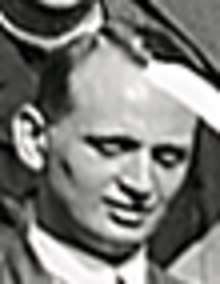Salomon Bochner
| Salomon Bochner | |
|---|---|
 Zürich 1932 | |
| Born |
20 August 1899 Podgórze, Austria-Hungary |
| Died |
2 May 1982 (aged 82) Houston, Texas |
| Nationality | Austrian American |
| Fields | Mathematics |
| Institutions | Munich, Princeton, IAS, Rice |
| Alma mater | University of Berlin |
| Doctoral advisor | Erhard Schmidt |
| Doctoral students |
Richard Askey Eugenio Calabi Jeff Cheeger M. T. Cheng Hillel Furstenberg Robert Gunning Israel Halperin Sigurdur Helgason Carl Herz Samuel Karlin Anthony Knapp Paco Lagerstrom Lynn Loomis Burton Randol Harry Rauch Herbert Scarf William A. Veech Gerard Washnitzer |
| Known for |
Bochner integral Bochner's theorem |
| Notable awards | AMS Steele Prize 1979[1][2] |
Salomon Bochner (20 August 1899 – 2 May 1982) was an American mathematician of Austrian-Hungarian origin, known for work in mathematical analysis, probability theory and differential geometry.
Life
He was born into a Jewish family in Podgórze (near Kraków), then Austria-Hungary, now Poland. Fearful of a Russian invasion in Galicia at the beginning of World War I in 1914, his family moved to Germany, seeking greater security. Bochner was educated at a Berlin gymnasium (secondary school), and then at the University of Berlin. There, he was a student of Erhard Schmidt, writing a dissertation involving what would later be called the Bergman kernel. Shortly after this, he left the academy to help his family during the escalating inflation. After returning to mathematical research, he lectured at the University of Munich from 1924 to 1933. His academic career in Germany ended after the Nazis came to power in 1933, and he left for a position at Princeton University. He was a visiting scholar at the Institute for Advanced Study in 1945-48.[3] He was appointed as Henry Burchard Fine Professor in 1959, retiring in 1968. Although he was seventy years old when he retired from Princeton, Bochner was appointed as Edgar Odell Lovett Professor of Mathematics at Rice University and went on to hold this chair until his death in 1982. He became Head of Department at Rice in 1969 and held this position until 1976. He died in Houston, Texas. He was an Orthodox Jew.[4]
Mathematical work
In 1925 he started work in the area of almost periodic functions, simplifying the approach of Harald Bohr by use of compactness and approximate identity arguments. In 1933 he defined the Bochner integral, as it is now called, for vector-valued functions. Bochner's theorem on Fourier transforms appeared in a 1932 book. His techniques came into their own as Pontryagin duality and then the representation theory of locally compact groups developed in the following years.
Subsequently he worked on multiple Fourier series, posing the question of the Bochner–Riesz means. This led to results on how the Fourier transform on Euclidean space behaves under rotations.
In differential geometry, Bochner's formula on curvature from 1946 was published. Joint work with Kentaro Yano (1912–1993) led to the 1953 book Curvature and Betti Numbers. It had consequences, for the Kodaira vanishing theory, representation theory, and spin manifolds. Bochner also worked on several complex variables (the Bochner–Martinelli formula and the book Several Complex Variables from 1948 with W. T. Martin).
Publications
- Bochner, Salomon (1992), Gunning, Robert C., ed., Collected papers. Part 1, Providence, R.I.: American Mathematical Society, ISBN 978-0-8218-0174-1, MR 1151390
- Bochner, Salomon (1992), Gunning, Robert C., ed., Collected papers. Part 2, Providence, R.I.: American Mathematical Society, ISBN 978-0-8218-0175-8, MR 1151391
- Bochner, Salomon (1992), Gunning, Robert C., ed., Collected papers. Part 3, Providence, R.I.: American Mathematical Society, ISBN 978-0-8218-0176-5, MR 1151392
- Bochner, Salomon (1992), Gunning, Robert C., ed., Collected papers. Part 4, Providence, R.I.: American Mathematical Society, ISBN 978-0-8218-0177-2, MR 1151393
See also
- Bochner–Kodaira–Nakano identity
- Bochner–Yano theorem
- Bochner identity
- Bochner integral
- Bochner space
References
External links
- O'Connor, John J.; Robertson, Edmund F., "Salomon Bochner", MacTutor History of Mathematics archive, University of St Andrews.
- Salomon Bochner at the Mathematics Genealogy Project
- National Academy of Sciences Biographical Memoir